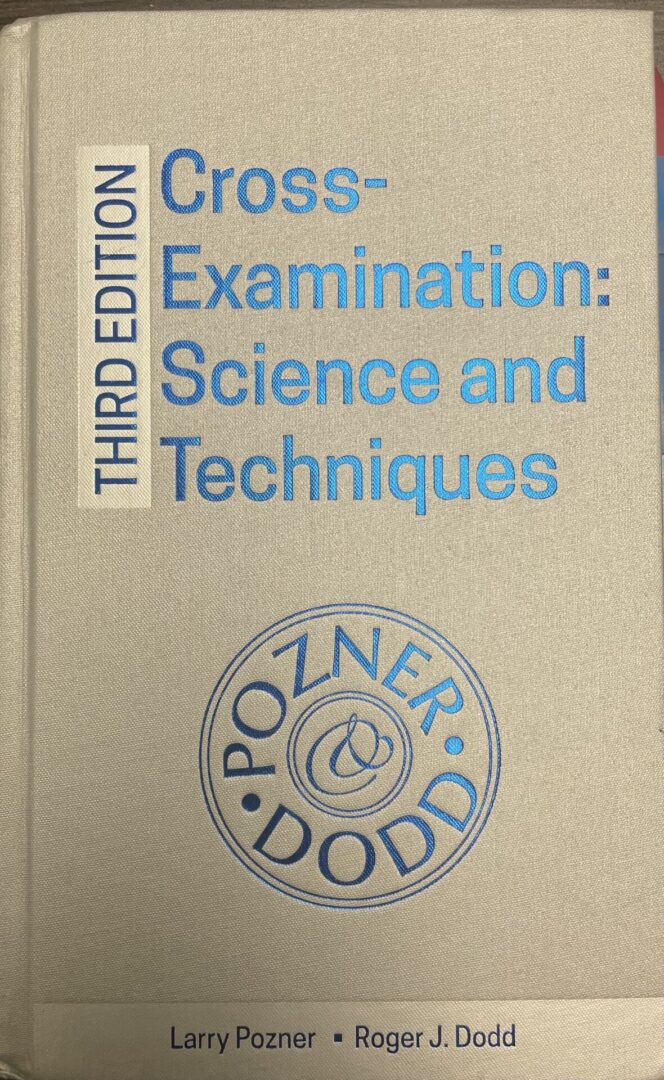Cross-Examination: Science and Techniques
By: Larry Pozner & Roger J. Dodd

This is likely the most thorough treatment of cross examination currently available in print. At 691 pages, the book provides an exhaustive discussion of every topic from how to prepare for cross examination to the minutiae of how to phrase and order questions for maximum impact. It is replete with examples and practical guidance, not just elementary rules.
The thrust of the book is the “Chapter Method of Cross Examination.” This method is a tool for trial lawyers to show their client’s story during cross examination; it focuses on developing necessary factual details in bite-sized chunks—the constituent chapters of the story. This is a rigorous process to plan, prepare for, and execute an impactful cross examination. The keystone of this methodology is the “chapter” itself—a discrete set of several questions tied to a single premise, which allows the jury to understand the import of the facts at the time they are elicited.
This chapter structure accomplishes several key goals. First, it ensures that the examination is tied to the theory of your case, because the questions are targeted to support the purpose of the chapter—like arguments under a point heading. Second, the structure uses detailed, objective facts that lead to an unavoidable conclusion. This conclusion is an inference that a hostile witness will struggle to avoid, but the facts already led the jury to the conclusion, whether the witness agrees with the conclusion or not. In the below example, the witness may be reluctant to agree the meeting was “important,” but the series of leading questions already show the jury it was an important meeting, and the witness’s reluctance to admit that conclusion only undermines her credibility. Third, the questions are grouped together to immediately show their significance to the jury.
The authors provide a useful example of the chapter method in the context of a corporate fraud case involving a corporate executive’s awareness of an audit. The “scene” (superstructure of chapters) at issue is a meeting between the executive and an auditor. That scene is deconstructed into numerous chapters, one being “The Importance of the Meeting.” Because the goal of the chapter is to prove the meeting was important, a series of leading questions are used to develop factual support for that conclusion—e.g., the meeting was one-on-one; the meeting took several hours; the auditor travelled across the country to attend; the meeting was held in the boardroom.
Pozner & Dodd explain the chapter method in great detail, and then they delve further into how to employ it for maximum effect. For example, the authors explain how to develop an examination based on your theory of the case and a common (lay) understanding of the law. In the fiduciary duty context, this may mean developing chapters to evoke feelings of dependence, trust, helplessness, and betrayal—thus providing a framework for the jury to understand the facts.
Pozner & Dodd also demonstrate how to prepare more refined and nuanced cross examinations. They explain that positive, “yes,” answers are more easily understood by jurors. They explain how to use loops and double loops to emphasize important facts without being repetitive. And they explain how to build trilogies, which use a compare/contrast paradigm to emphasize facts.
Even for an experienced trial lawyer, this book is likely to improve the way you plan and prepare your case and can certainly help refine the structure and phrasing of questions. For a less experienced trial lawyer, this book will lay the groundwork to become a truly skilled cross examiner. For every lawyer, this book should serve as a reference to prepare for cross examination.